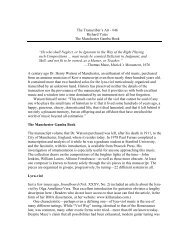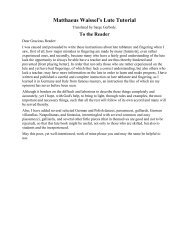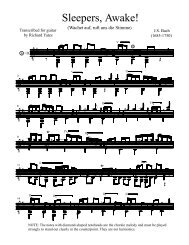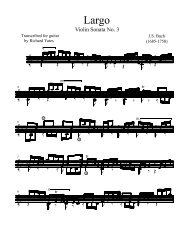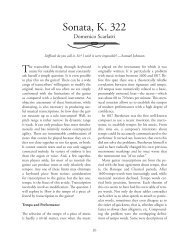Article38-Beach - Richard Yates Classical Guitar Transcriptions
Article38-Beach - Richard Yates Classical Guitar Transcriptions
Article38-Beach - Richard Yates Classical Guitar Transcriptions
You also want an ePaper? Increase the reach of your titles
YUMPU automatically turns print PDFs into web optimized ePapers that Google loves.
#<br />
& # c<br />
Œ<br />
œ<br />
œ Œ œ<br />
#<br />
& # c<br />
œ Œ<br />
œ Œ<br />
œ œ<br />
Figure 1<br />
The entire piece uses this texture except for the couple of measures of scale melody. The first<br />
of each pair of beamed eighth notes has a quarter note stem showing that it is to be held<br />
(‘tenuto’) through the end of the following eighth note when they are then both released. The<br />
left and right hands alternate in this fashion. The quarter-stemmed notes do not by themselves<br />
form a melody, so the teaching purpose of the piece seems to be to train the basic keyboard<br />
motion of holding down a note while then playing another one with a finger of the same hand.<br />
Although the mechanics of doing this on the piano are unlike those of the guitar, there certainly<br />
are technical issues related to note duration that are necessary for guitarists to master. While<br />
our errors are often in the opposite direction—allowing notes to ring over too long (‘troppo<br />
tenuto’?)—we also must learn how to maintain them just as <strong>Beach</strong> is trying to teach.<br />
Transcribers can collude in these errors or help correct them through the fingerings that they<br />
choose.<br />
The over-ringing of notes in arpeggio textures is an idiomatic feature of guitar music that<br />
can be supported through fingering choices and I have attempted to do this throughout the<br />
transcription of Secrets. The standard that I tried to meet was to have every arpeggio note<br />
fingered so that it could he held past the start of the next note. This accounts for the<br />
occasionally arcane fingerings that you see in the score and the plethora of fingering numbers<br />
(‘troppo notazione’!?). There are places where this standard simply could not be maintained,<br />
but still I may have pushed the limits beyond what is reasonable or feasible for some players.<br />
For those readers who find my little exercise excessive or frustrating, and who are getting a<br />
little dizzy from all of the white-out they are slathering on the score, I have posted a file of<br />
Secrets entirely without fingering on my website at www.yatesguitar.com/secrets.pdf.<br />
Minuet, Op. 36, No. 1<br />
The Minuet is the first of five pieces in Children’s Album, Op. 36 all of which are suitable for<br />
guitar transcription. It combines grace, elegance and delicate harmonic sense within a small<br />
form. The piano score is contained on two treble staffs and a range of barely two octaves.<br />
Transposed from F major to G major in the guitar transcription, it sits entirely on the first five<br />
strings and required no unusual modifications. Because the sixth string is not used, it could fit<br />
comfortably into a recital program before a piece that uses drop D tuning—just tune the sixth<br />
string down before the Minuet and it will have settled into that pitch well before you need it.<br />
If you have alternate strategies for transcribing these pieces, please get in touch through:<br />
<strong>Richard</strong> <strong>Yates</strong><br />
richard@yatesguitar.com<br />
http://www.yatesguitar.com<br />
œ


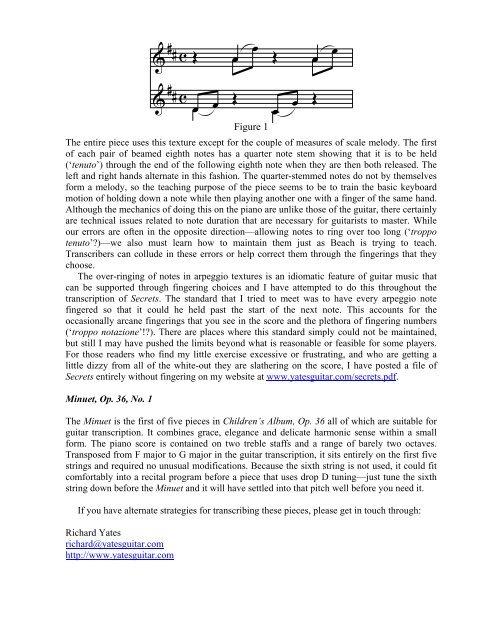


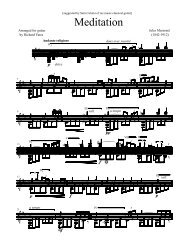
![Finale 2005b - [BWV846-Prelude in C.MUS]](https://img.yumpu.com/43978887/1/190x245/finale-2005b-bwv846-prelude-in-cmus.jpg?quality=85)
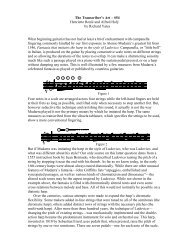
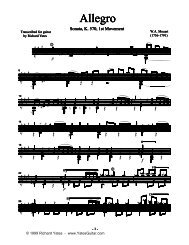
![Finale 2005b - [AirG-TAB.MUS] - Richard Yates Classical Guitar ...](https://img.yumpu.com/37104901/1/190x245/finale-2005b-airg-tabmus-richard-yates-classical-guitar-.jpg?quality=85)

